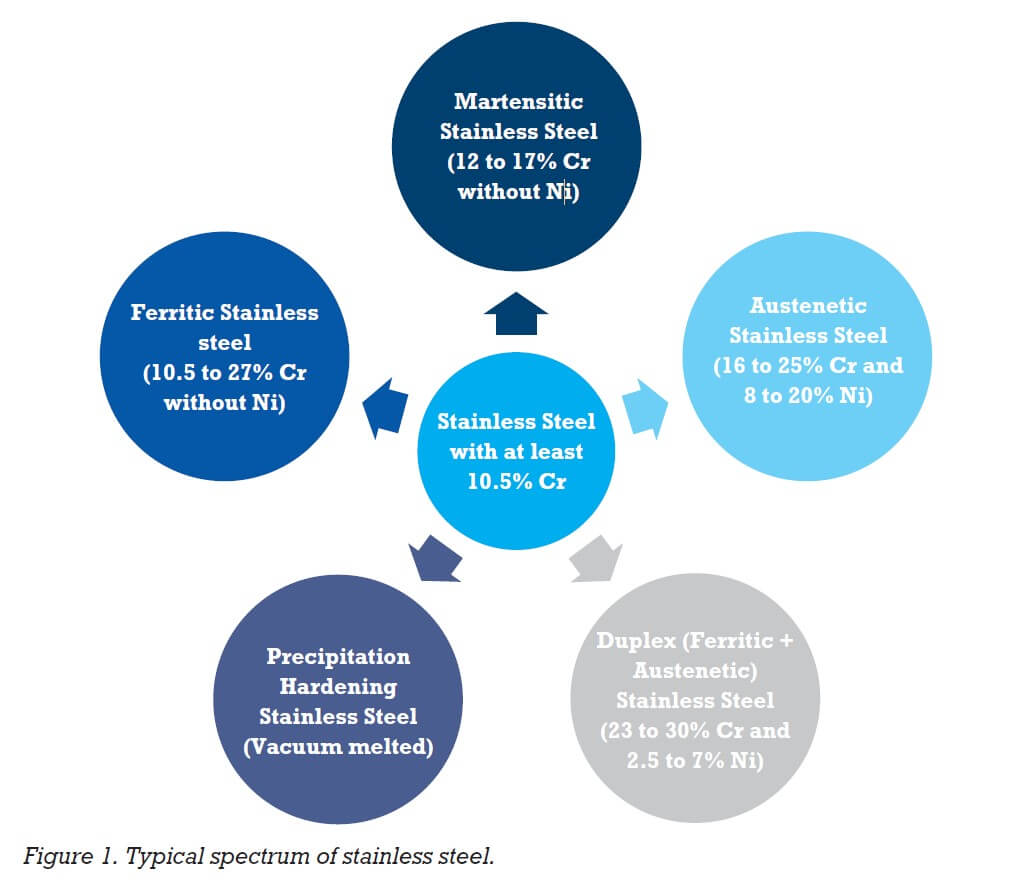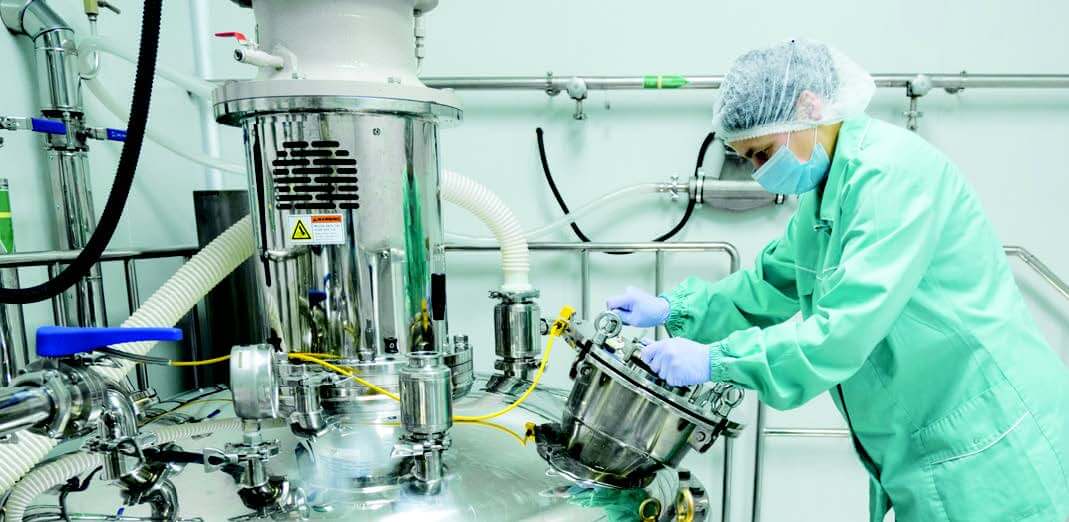The aircraft industry is an important user of martensitic stainless steels.
The stainless steel spectrum is typically defined as ferritic, martensitic, austenitic, duplex, and precipitation-hardenable. Over 100 grades of stainless steel are grouped within these five categories, each of which is unique in terms of composition, structure and scope.
By Ashok Kr. Vaish*, Mukesh Kumar**, Ankit Bhojani*, Parmjeet Singh**, B. J. Chauhan*, and S. K. Bhatnagar**- *Department of Metallurgical and Materials Engineering, The M. S. University of Baroda, Vadodara; ** Ministry of Steel, Government of India, New Delhi.
Stainless steel is an alloy essentially comprised of iron, at least 10.5% chromium, ≤ 1.2% carbon, and other alloying elements. The argon oxygen decarburisation (AOD) process is universally accepted as the most efficient process for producing stainless steel of different grades. In contrast, the vacuum oxygen deoxidisation (VOD) process produces extra-low carbon (≈ 0.02%) stainless steel at little additional cost.
The corrosion resistance and mechanical properties of stainless steels are enhanced by alloying elements such as nickel, molybdenum, nitrogen, titanium, niobium, manganese, etc. Chromium forms a stable oxide (Cr2O3) film on the surface, which is continuous, impervious and passive to stop any further reaction between the steel and the surrounding atmosphere and protects the steel from further oxidation.
Other alloying elements affect formability, weldability, strength, oxidation resistance and reduction in thickness due to cold rolling.
Ferritic stainless steels
Ferritics are made up of microstructures known as ferrite and have a bodycentred- cubic grain structure.
Ferritic stainless steel contains over 12% chromium with less than 0.20% carbon. They are non-hardenable by heat treatment and only marginally hardenable by cold rolling. The bodycentred- cubic grain is responsible for ferritic steel’s magnetic nature, and in this it differs from all other types of stainless steel.
While not as strong as martensitics, ferritics are highly corrosion resistant. They are commonly used for kitchen equipment, industrial machinery and in the auto industry. Ferritics are an alternative to austenitics to manufacture thin film products such as exhaust tubing, washing machine drums, containers, buses, train compartments, LCD monitor displays, microwaves and solar water heaters. Compared to austenitic stainless steels, ferritic stainless steels are cheap due to the absence of expensive nickel. Due to their reasonable cold formability, ferritic stainless steel designs can be easily fabricated. Chromium rich ferritic stainless steels have good oxidation resistance at high temperatures and can be used to make furnace components.
Martensitic stainless steel

Martensitics contain 12-17 % chromium and 0.10 to 1.20 % carbon. This steel is quenched in oil or air from 1050°C (when fully austenitic) and then tempered. The tempering temperature is kept low for high tensile and yield strength with low toughness, whereas higher toughness is achieved at high tempering temperatures. In general, martensitic stainless steel can be hardened and tempered to obtain the yield strength of 550-1860 MPa. Its hardenability increases with chromium content. These steels are air hardened in large sections. Based on the percentage of carbon, martensitic stainless steel can be divided into two categories:
- • Low carbon high strength martensitic steel: The carbon content is kept low (about 0.10 %) and chromium content varies from 11.50 to 18.00%. These are primarily high strength structural steels possessing good weldability, formability and good impact toughness. They are used in (petro) chemical plant construction, gas turbine engines, turbine blades, electrical generation plants, compressors, discs and aircraft structural and engine applications, and freshwater propeller shafts. Also widely used for components such as bolts, valves, cutlery items, pump shafts and bearings.
- • High carbon high hardness martensitic steel: Both strength and hardness are increased by raising the carbon content at the expense of weldability, toughness and even corrosion resistance. It also increases the amount of carbides that require higher austenitising temperatures to dissolve them, which gives lower impact properties.
Common applications include cutlery (with 0.3% C and 12 % chromium with a hardness of 400 VPN after hardening and tempering); gears, bearings, needle valves and components for high-temperature applications; razor blades; surgical implements, coal hammers and ball bearings for hightemperature applications (with 0.95 to 1. 20 %C and 16-17 %Cr and hardness of 600-700 VPN after tempering). Martensitic steel is extremely suitable for aerospace, defence and power hand tools because of its durability, strength, and corrosion resistance.
Austenitic stainless steel
Austenitics are the most popular stainless steel, recognised for their high corrosion resistance and temperature stability. They are known for their unparalleled strength and formability and cannot be hardened by heat treatment. They are considered expensive due to their high nickel content, with a minimum of 10.5% chromium and 8-12% nickel, plus nitrogen and other elements.
Austenitics present an austenite crystalline structure, and the facecentred- cubic lattice structure is present at both hot and cold temperatures. Magnesium, nickel, and nitrogen are stabilising elements; steel becomes ‘austenite’ by nature by adding nickel or nitrogen.
Austenitic steel is weldable, formable and typically non-magnetic and is used in various industries, including the medical, automotive, industrial, consumer and aerospace sectors.
High chromium grades, with excellent oxidation and scaling resistance, are used in steam pipes, boiler tubes, radiant superheater tubes, furnace parts etc. High molybdenum stainless steels are used for brackish or seawater cooling heat exchangers/condenser tube applications for power stations, offshore platform process piping, and industries such as pulp and paper. They provide trouble-free seawater service for pumps, propellers, valves, and other marine equipment.
In nuclear power plants, austenitic stainless steel is used for piping for process-related vessels. It can withstand higher temperatures than ferritic steel, even though both may be present in a typical reactor.
Austenitics also exhibit a wide range of properties that enable them to be used at cryogenic temperatures, where they have high tensile strength, although their toughness is slightly degraded. They are extensively employed for LNG applications at temperatures of -161°C, and in plants for generating liquefied gases.

The 300 series and the 200 series of austenitic stainless steel are utilised in a wide range of sectors:
300 Series – Mining and chemical equipment, pharmaceutical equipment, tanks, components for catalytic converters, food and beverage, aerospace tubing.
200 Series – Cookware and cutlery, home water tanks, dishwashers, indoor architecture, automobile parts, washing machines.
Thus, austenitic stainless steel has many beneficial attributes that make it a popular material, and it makes up around three-quarters of the global stainless steel market.
Duplex stainless steel
Duplex combines the toughness and weldability of austenite with the strength and localised corrosion resistance of ferrite. Its dual ferrite and austenite microstructure is obtained by balancing the chromium and nickel equivalent elements. Normally, duplex steel has 23-30 % Cr, 2.5-7% Ni and some titanium or molybdenum. Duplexes are extremely corrosion resistant, work hardenable alloys. They are about twice as strong as regular austenitic or ferritic stainless steel. Super duplex stainless steel has a higher molybdenum and chromium content for greater corrosion resistance.
Duplexes are used in chemical processing, transport and storage, pipes for production and transportation of oil and gas, oil and gas exploration and offshore rigs. Other common applications include pressure vessels and heat exchangers, paper & pulp digesters, bleaching equipment, food processing, biofuel plants, marine and high chloride conditions.
Precipitation–hardening stainless
These steels are a combination of austenitic and martensitic steels enriched with copper, molybdenum, aluminium, and titanium, either alone or in combination. Precipitation– hardening (PH) stainless steels are used for high strength to weight ratio applications and are particularly useful for high-temperature applications such as power plants. They can be heat treated to provide tensile strengths of 850 to 1700 MPa and yield strengths of 520 MPa to 1500 MPa – some three or four times that of austenitic stainless steel such as type 304 or type 316.
The family of PH stainless steels can be divided into three main types – low carbon martensitic, semi-austenitic and austenitic. They are used in the oil & gas, nuclear, and aerospace industries where a combination of high strength, corrosion resistance and a generally low but acceptable degree of toughness is required. Special uses include highspeed applications such as turbine blades.
17-4 PH stainless steel plate is prized for its ability to simplify fabrication and manufacturing processes, resulting in significant cost savings. Engineers worldwide rely on this PH stainless steel as a solution to pressing logistical problems in product design, manufacturing and processing. Typical usage of 17-4 stainless steel is castings that require high strength and a modest level of corrosion resistance. The desired strength and toughness can be manipulated by the temperature range in the heat treatment process.
Impressive spectrum
The spectrum of stainless steel is impressive and everexpanding due largely to its versatile applications, even under extreme environmental conditions. The global market is expected to have a compound annual growth rate of 6.3 % from 2019 to 2027 to reach USD 182.1 billion by 2027. As per capita stainless steel consumption grows, it has a vast scope to benefit from increased demand and production. Stainless steel has truly become the metal of the future due to its iconic applications.
Every week we share a new Featured Story with our Stainless Steel community. Join us and let’s share your Featured Story on Stainless Steel World online and in print.


